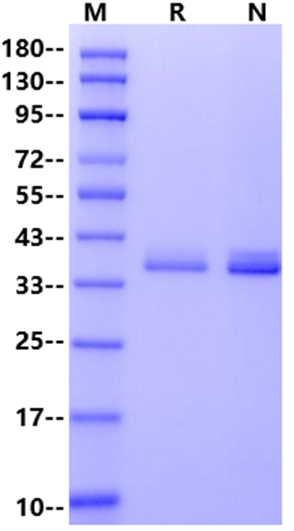产品介绍 评论(0)
物种
Human抗原名称
Apolipoprotein E/APOE4分子别名
APOE, Apo-EAccession
P02649表达序列
Lys19-His317 (C130R), with C-terminal 8*His Tag KVEQAVETEPEPELRQQTEWQSGQRWELALGRFWDYLRWVQTLSEQVQEELLSSQVTQELRALMDETMKELKAYKSELEEQLTPVAEETRARLSKELQAAQARLGADMEDVRGRLVQYRGEVQAMLGQSTEELRVRLASHLRKLRKRLLRDADDLQKRLAVYQAGAREGAERGLSAIRERLGPLVEQGRVRAATVGSLAGQPLQERAQAWGERLRARMEEMGSRTRDRLDEVKEQVAEVRAKLEEQAQQIRLQAEAFQARLKSWFEPLVEDMQRQWAGLVEKVQAAVGTSAAPVPSDNHGGGSHHHHHHHH
表达宿主
HEK293分子量
35-40kDa纯度
>95% by SDS-PAGE内毒素含量
<0.1EU/μg标记
Unconjugated标签
His Tag性状
Lyophilized powder缓冲体系
PBS, pH7.4溶解方法
Reconstitute at 0.1-1 mg/ml according to the size in ultrapure water after rapid centrifugation.储存条件
12 months from date of receipt, -20 to -70 °C as supplied; 6 months, -20 to -70 °C under sterile conditions after reconstitution; 1 week, 2 to 8 °C under sterile conditions after reconstitution; Please avoid repeated freeze-thaw cycles.
文献引用
1. Na Zhao, Chia-Chen Liu, Wenhui Qiao. Apolipoprotein E, Receptors, and Modulation of Alzheimer's Disease. Biol Psychiatry. 2018 Feb 15;83(4):347-357. doi: 10.1016/j.biopsych.2017.03.003. Epub 2017 Mar 14.
Apolipoprotein E (apoE) is a lipid carrier in both the peripheral and the central nervous systems. Lipid-loaded apoE lipoprotein particles bind to several cell surface receptors to support membrane homeostasis and injury repair in the brain. Considering prevalence and relative risk magnitude, the ε4 allele of the APOE gene is the strongest genetic risk factor for late-onset Alzheimer's disease (AD). ApoE4 contributes to AD pathogenesis by modulating multiple pathways, including but not limited to the metabolism, aggregation, and toxicity of amyloid-β peptide, tauopathy, synaptic plasticity, lipid transport, glucose metabolism, mitochondrial function, vascular integrity, and neuroinflammation.
电泳JSON

1μg (R: reducing condition, N: non-reducing condition).



评论(0)